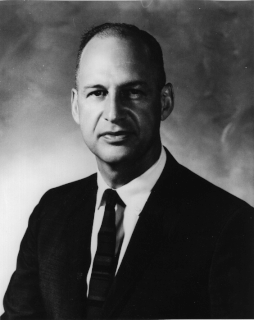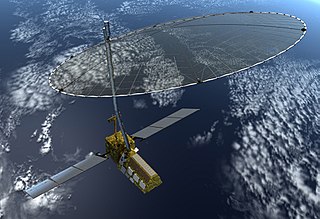
The Apollo program, also known as Project Apollo, was the third United States human spaceflight program carried out by the National Aeronautics and Space Administration (NASA), which succeeded in landing the first humans on the Moon from 1969 to 1972. First conceived during Dwight D. Eisenhower's administration as a three-person spacecraft to follow the one-person Project Mercury, which put the first Americans in space. Apollo was later dedicated to President John F. Kennedy's national goal of "landing a man on the Moon by the end of this decade and returning him safely to the Earth" in an address to Congress on May 25, 1961. It was the third US human spaceflight program to fly, preceded by the two-person Project Gemini conceived in 1961 to extend spaceflight capability in support of Apollo.

The John F. Kennedy Space Center, located in Merritt Island, Florida, is one of ten National Aeronautics and Space Administration field centers. Since December 1968, KSC has been NASA's primary launch center of human spaceflight. Launch operations for the Apollo, Skylab and Space Shuttle programs were carried out from Kennedy Space Center Launch Complex 39 and managed by KSC. Located on the east coast of Florida, KSC is adjacent to Cape Canaveral Air Force Station (CCAFS). The management of the two entities work very closely together, share resources, and even own facilities on each other's property.

The Jet Propulsion Laboratory (JPL) is a federally funded research and development center and NASA field center in the city of La Cañada Flintridge with a Pasadena mailing address, within the state of California, United States.

Project Mercury was the first human spaceflight program of the United States, running from 1958 through 1963. An early highlight of the Space Race, its goal was to put a man into Earth orbit and return him safely, ideally before the Soviet Union. Taken over from the US Air Force by the newly created civilian space agency NASA, it conducted twenty uncrewed developmental flights, and six successful flights by astronauts. The program, which took its name from Roman mythology, cost $2.25 billion adjusted for inflation. The astronauts were collectively known as the "Mercury Seven", and each spacecraft was given a name ending with a "7" by its pilot.

The Hubble Space Telescope is a space telescope that was launched into low Earth orbit in 1990 and remains in operation. It was not the first space telescope but it is one of the largest and most versatile, well known both as a vital research tool and as a public relations boon for astronomy. The Hubble telescope is named after astronomer Edwin Hubble and is one of NASA's Great Observatories, along with the Compton Gamma Ray Observatory, the Chandra X-ray Observatory, and the Spitzer Space Telescope.

The Ames Research Center (ARC), also known as NASA Ames, is a major NASA research center at Moffett Federal Airfield in California's Silicon Valley. It was founded in 1939 as the second National Advisory Committee for Aeronautics (NACA) laboratory. That agency was dissolved and its assets and personnel transferred to the newly created National Aeronautics and Space Administration (NASA) on October 1, 1958. NASA Ames is named in honor of Joseph Sweetman Ames, a physicist and one of the founding members of NACA. At last estimate NASA Ames has over US$3 billion in capital equipment, 2,300 research personnel and a US$860 million annual budget.

The Lunar Orbiter program was a series of five unmanned lunar orbiter missions launched by the United States from 1966 through 1967. Intended to help select Apollo landing sites by mapping the Moon's surface, they provided the first photographs from lunar orbit and photographed both the Moon and Earth.

The Lyndon B. Johnson Space Center (JSC) is NASA's center for human spaceflight, where human spaceflight training, research, and flight control are conducted. It was built and leased to NASA by Joseph L. Smith & Associates, Inc. It was renamed in honor of the late US president and Texas native, Lyndon B. Johnson, by an act of the United States Senate on February 19, 1973.

The James Webb Space Telescope is a space telescope that is planned to be the successor to the Hubble Space Telescope. The JWST will provide improved infrared resolution and sensitivity over Hubble, and will enable a broad range of investigations across the fields of astronomy and cosmology, including observing some of the most distant events and objects in the universe, such as the formation of the first galaxies. Other goals include understanding the formation of stars and planets, and direct imaging of exoplanets and novas.

George Michael Low was a NASA administrator and 14th President of Rensselaer Polytechnic Institute.

The Mercury Seven were the group of seven astronauts selected to fly spacecraft for Project Mercury. They are also referred to as the Original Seven and Astronaut Group 1. Their names were publicly announced by NASA on April 9, 1959. These seven original American astronauts were Scott Carpenter, Gordon Cooper, John Glenn, Gus Grissom, Wally Schirra, Alan Shepard, and Deke Slayton. The Mercury Seven created a new profession in the United States, and established the image of the American astronaut for decades to come.
The Lunar Precursor Robotic Program (LPRP) is a program of robotic spacecraft missions which NASA has used to prepare for future human spaceflight missions to the Moon by 2010. Two LPRP missions, the Lunar Reconnaissance Orbiter (LRO) and the Lunar Crater Observation and Sensing Satellite (LCROSS), were launched in June 2009. The lift off above Cape Canaveral Air Force Station in Florida was successful on June 18, 2009. The unmanned Atlas V rocket launched the two space probes towards the Moon, where they will provide a 3-D map and search for water in conjunction with the Hubble Space Telescope.

NASA WorldWind is an open-source virtual globe. It was first developed by NASA in 2003 for use on personal computers and then further developed in concert with the open source community since 2004. As of 2017, a web-based version of WorldWind is available online. An Android version is also available.

NASA Astronaut Group 4 was a group of six astronauts selected by NASA in June 1965. While the astronauts of the first two groups were required to have an undergraduate degree or the professional equivalent in engineering or the sciences, they were chosen for their experience as test pilots. Test pilot experience was waived as a requirement for the third group, and military jet fighter aircraft experience could be substituted. Group 4 was the first chosen on the basis of research and academic experience, with NASA providing pilot training as necessary. Initial screening of applicants was conducted by the National Academy of Sciences.

Dave Lavery is an American scientist and roboticist who is the Program Executive for Solar System Exploration at NASA Headquarters. He also is a member of the FIRST Executive Advisory Board, and is well-known among participants of the FIRST Robotics Competition as a mentor of Team 116.

A human mission to Mars has been the subject of science fiction, aerospace engineering, and scientific proposals since the 20th century. Plans include landing on Mars for exploration at a minimum, with the possibility of sending settlers and terraforming the planet and/or exploring its moons Phobos and Deimos also considered.

The National Aeronautics and Space Administration is an independent agency of the United States Federal Government responsible for the civilian space program, as well as aeronautics and aerospace research.

The Parker Solar Probe is a NASA robotic spacecraft launched in 2018, with the mission of repeatedly probing and making observations of the outer corona of the Sun. It will approach to within 9.86 solar radii from the center of the Sun and by 2025 will travel, at closest approach, as fast as 690,000 km/h (430,000 mph), or 0.064% the speed of light.

The Wide Field Infrared Survey Telescope (WFIRST) is a NASA infrared space observatory currently under development. WFIRST was recommended in 2010 by United States National Research Council Decadal Survey committee as the top priority for the next decade of astronomy. On 17 February 2016, WFIRST was approved for development and launch.

The NASA-ISRO Synthetic Aperture Radar (NISAR) mission is a joint project between NASA and ISRO to co-develop and launch a dual-frequency synthetic aperture radar on an Earth observation satellite. The satellite will be the first radar imaging satellite to use dual frequencies. It will be used for remote sensing, to observe and understand natural processes on Earth. For example, its right-facing instruments will study the Antarctic cryosphere.


















